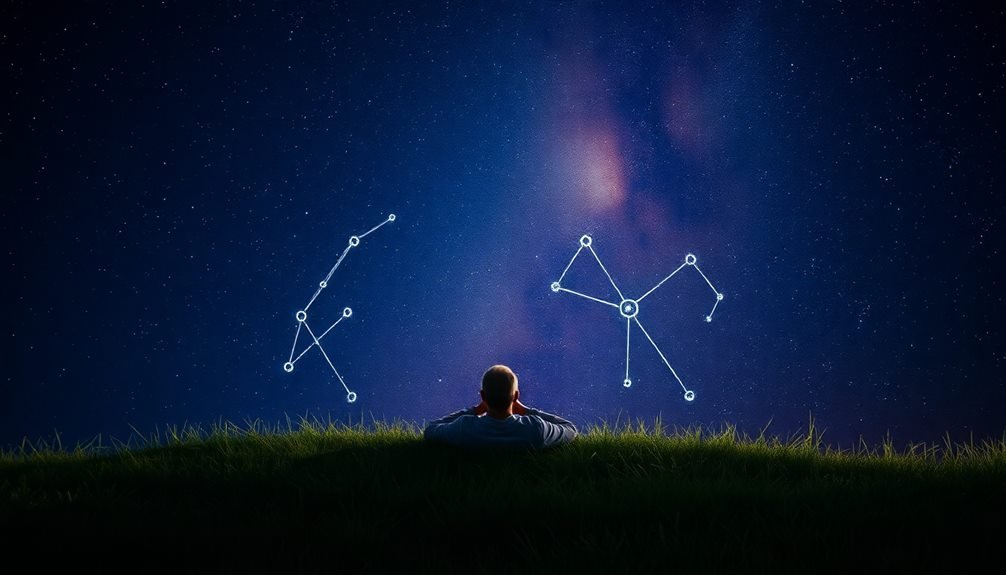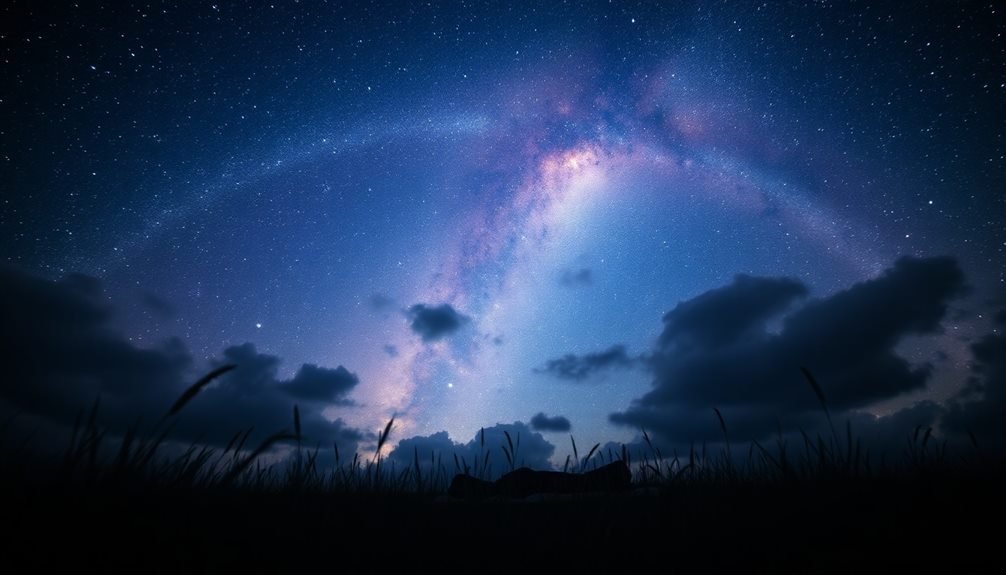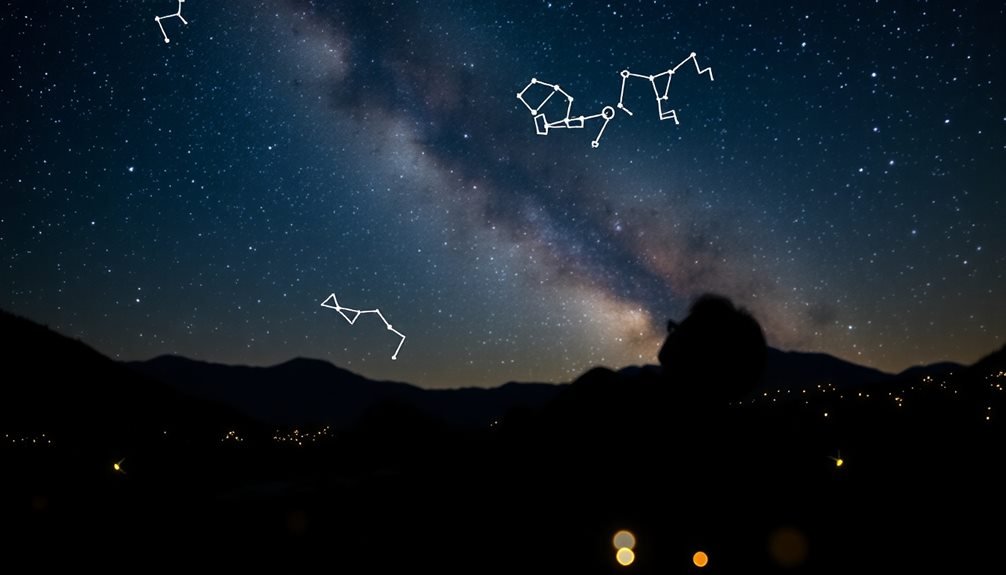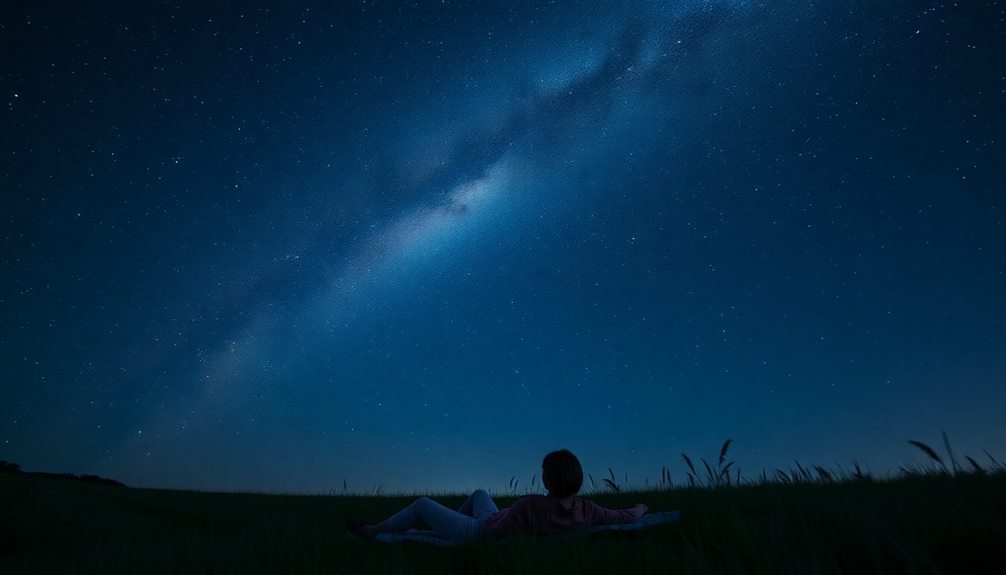Stargazing naturally calms your anxious mind through several powerful mechanisms. When you look up at the night sky, your brain releases dopamine and serotonin, promoting relaxation and well-being. The darkness triggers melatonin production, helping regulate your sleep cycles, while scanning the vast celestial expanse shifts your brain waves into a meditative state. You'll find comfort in the Moon's predictable 29.5-day cycle and the timeless patterns of constellations that have guided humanity for millennia. The "awe effect" of contemplating the universe's magnitude helps put your daily worries into perspective, offering a gateway to deeper tranquility.
The Science Behind Stargazing Relief

Looking up at the vast night sky triggers several neurological and psychological responses that help reduce anxiety. When you gaze at stars, your brain releases dopamine and serotonin, neurotransmitters known for promoting feelings of well-being and relaxation.
The natural darkness also stimulates melatonin production, which helps regulate your sleep-wake cycle and reduces stress levels.
The repetitive pattern of scanning the night sky creates a meditative state, similar to mindfulness practices. Your brain enters a lower frequency wave pattern, shifting from beta to alpha waves, which indicates a more relaxed mental state.
This astronomical observation also activates your brain's default mode network, associated with introspection and reduced anxiety.
You'll experience what psychologists call the "awe effect" when stargazing. This phenomenon occurs when you're confronted with something vast and incomprehensible, leading to a diminished focus on daily worries.
The perspective gained from observing celestial bodies helps reduce the perceived magnitude of your problems, as your brain processes the immense scale of the universe in relation to your immediate concerns.
Finding Your Perfect Stargazing Spot
Selecting your ideal stargazing location starts with finding Dark Sky areas away from city lights and light pollution.
You'll want to prioritize your comfort and safety by bringing essential items like a reclining chair, warm blankets, and a fully charged phone.
Before heading out, it's smart to check weather conditions and let someone know where you'll be, especially if you're planning to stargaze in remote locations.
Dark Sky Locations
To find your perfect stargazing spot, identifying a dark sky location away from light pollution is crucial. Dark sky locations are areas with minimal artificial light interference, allowing you to see celestial objects clearly. You'll find these pristine viewing conditions in rural areas, national parks, and designated dark sky preserves.
Use online dark sky maps and light pollution charts to locate ideal viewing areas near you. The International Dark-Sky Association (IDA) maintains a database of certified dark sky places worldwide. These locations undergo rigorous evaluation to verify they meet specific criteria for minimal light pollution and sky quality.
When selecting your dark sky location, consider factors like accessibility, safety, and elevation. Higher altitudes often provide clearer views due to reduced atmospheric interference. Look for spots with unobstructed horizons and minimal tree cover.
If you can't travel far, seek out local astronomical societies that might've access to private observing sites.
Remember to check weather conditions before heading out. Clear, moonless nights offer the best visibility, and cooler temperatures typically provide steadier atmospheric conditions for viewing stars and planets.
Comfort and Safety First
A safe stargazing setup guarantees you'll stay comfortable during hours of celestial observation. Start by choosing a flat, stable surface away from hazards like steep slopes or hidden holes. Bring a reclining chair or padded blanket to prevent neck strain while looking up, and position yourself where trees or structures won't block your view.
You'll need to dress appropriately since temperatures often drop considerably at night. Layer your clothing, including a moisture-wicking base layer, insulating middle layer, and wind-resistant outer layer. Don't forget a hat, gloves, and warm socks.
Keep emergency supplies like a flashlight with red light (to preserve night vision), water, snacks, and a basic first aid kit within arm's reach.
If you're stargazing alone, always inform someone of your location and expected return time. Consider bringing a companion for both safety and shared experience. Keep your phone charged but face-down to avoid light pollution, and download a stargazing app beforehand.
Check weather forecasts to avoid unexpected rain or dangerous conditions, and guarantee you've got clear access to your vehicle or shelter if needed.
Mindful Night Sky Observation

Mindful observation of the night sky begins with finding a comfortable position and letting your thoughts settle like stardust. Take slow, deep breaths while directing your gaze upward, allowing your eyes to naturally adjust to the darkness over 20-30 minutes.
Rather than frantically searching for constellations, let your eyes wander naturally across the sky's canvas. You'll notice patterns emerging as your vision adapts – first the brightest stars, then gradually fainter ones. Focus on one area at a time, observing how stars cluster and space themselves across the darkness.
When your mind wanders, gently redirect it to the vastness above. Notice how the sky's movement mirrors your breath – steady, constant, and rhythmic. You're not just watching the stars; you're connecting with a view that humans have shared for millennia.
Pay attention to how the experience affects your senses. You might notice the cool night air, distant sounds, or the contrast between light and shadow. This mindful engagement helps anchor you in the present moment, creating distance from anxious thoughts while fostering a deeper connection with the natural world.
Connecting With Celestial Patterns
You'll find comfort in the timeless stories etched across the night sky, where ancient civilizations mapped their myths and legends into the stars you can still spot today.
By following the moon's predictable phases from new to full, you're establishing a reassuring connection to nature's most reliable rhythms.
When you learn to spot familiar geometric patterns like triangles, squares, and curves in constellations, you're creating personal touchstones that make the vast cosmos feel more approachable and friendly.
Recognizing Ancient Sky Stories
Looking up at the night sky connects us to countless generations of human storytellers who found meaning in celestial patterns. When you learn the ancient myths behind constellations, you're participating in a tradition that spans cultures and millennia.
These timeless stories can help reduce anxiety by shifting your focus from daily worries to the vast cosmic perspective that guided our ancestors.
You'll find that every major civilization created its own celestial narratives. The Greeks saw Orion the hunter in the stars, while Aboriginal Australians recognized the Emu in the dark spaces of the Milky Way.
Learning these stories gives you a sense of human continuity and reminds you that your challenges are part of a broader human experience. When anxiety strikes, you can practice grounding yourself by identifying these ancient patterns and recalling their stories.
Try starting with easily recognizable constellations like Ursa Major (the Big Dipper) or Orion's Belt. As you become familiar with these celestial landmarks, you'll develop a personal connection to the sky stories that have brought comfort and wonder to people throughout history.
Tracking Moon Phase Changes
The Moon's predictable rhythm offers a natural anchor for managing anxiety through celestial observation. By tracking lunar phases, you'll discover a consistent 29.5-day cycle that helps ground your thoughts and create a sense of order amid life's uncertainties.
Start by observing the Moon's appearance each clear night, noting its shape, position, and the time you see it. You can strengthen your connection to lunar patterns by keeping a simple moon journal. Record the phase you observe, from new moon to waxing crescent, first quarter, waxing gibbous, full moon, and through the waning phases.
Notice how these changes align with your own emotional rhythms and daily experiences. Download a moon-tracking app to verify your observations and predict future phases.
As you become familiar with the Moon's dependable cycle, you'll find comfort in its regular changes. This celestial pattern-watching can reduce anxiety by shifting focus from immediate stressors to the broader natural rhythm that's existed for billions of years.
Each phase represents both change and constancy, reminding you that challenging moments, like the Moon's darker phases, always yield to brighter ones.
Finding Universal Star Shapes
Beyond the Moon's familiar face, star patterns offer another powerful tool for anxiety relief through their universal shapes and stories. When you identify repeating geometric forms in the night sky, you're connecting with the same patterns humans have observed for millennia.
Start with the easiest shapes: the Big Dipper's ladle formation, Orion's hourglass figure, and the Summer Triangle's perfect geometric form. You'll find that focusing on these celestial patterns helps quiet racing thoughts, as your mind shifts from daily concerns to cosmic connections.
Train your eyes to spot the "W" shape of Cassiopeia or the "Y" formation in Boötes. These recognizable configurations serve as reliable anchors in the vast expanse above, providing a sense of stability and order during anxious moments.
As you practice identifying these stellar shapes, you're engaging in a form of celestial mindfulness. The predictable patterns become familiar friends, offering comfort through their constancy.
Create your own shape-finding routine by selecting three to four key formations to locate each night, establishing a calming ritual that grounds you in the present moment.
Best Times For Anxiety Relief

Choosing an ideal time for stargazing can maximize its anxiety-relieving benefits. You'll find the most therapeutic effects between 9 PM and midnight when your body naturally begins producing melatonin, the sleep hormone that helps reduce stress. This timing aligns with your circadian rhythm, making you more receptive to relaxation.
The two hours after sunset offer particularly calming conditions. During this period, you'll notice the gradual emergence of stars as twilight fades, which can help slow racing thoughts and promote mindfulness.
If you're dealing with daytime anxiety, plan your stargazing sessions during new moon phases when the sky is darkest and stars appear more vivid.
Weekend evenings often work best because you won't feel rushed or worried about next-day responsibilities. You'll want to spend at least 20-30 minutes outside to allow your eyes to adjust to the darkness and your mind to settle.
During meteor showers or celestial events, try arriving 30 minutes before peak viewing times – this buffer period lets you acclimate to the environment and establish a peaceful mindset before the main show begins.
Essential Stargazing Equipment
Essential equipment for anxiety-relieving stargazing comes down to just a few key items.
You'll want to invest in tools that enhance your viewing experience while maintaining comfort during your relaxation sessions. While professional astronomers use complex equipment, you don't need expensive gear to begin your therapeutic stargazing practice.
- A comfortable reclining chair or blanket that allows you to lay back without neck strain – this is vital for extended viewing sessions and proper relaxation.
- Red flashlight or headlamp to preserve your night vision while maneuvering or consulting star charts, as white light can disrupt your eyes' dark adaptation.
- Basic star chart or astronomy app on your phone to help identify celestial objects, making your experience more engaging and purposeful.
- Weather-appropriate clothing and possibly a blanket, as staying warm and comfortable is essential for anxiety relief.
Start with these fundamental items before considering more advanced equipment like binoculars or telescopes.
Remember, the goal is to create a peaceful stargazing experience that reduces anxiety, so keep your setup simple and manageable.
Focus on comfort and basic navigation tools rather than complex astronomical equipment.
Frequently Asked Questions
Can Stargazing Help With Specific Phobias Like Fear of Darkness?
Yes, stargazing can help reduce your fear of darkness by giving you a positive focus in the night. You'll gradually associate darkness with beautiful celestial sights rather than fear, making it less intimidating.
How Do Urban Light Conditions Affect the Therapeutic Benefits of Stargazing?
You'll find urban light pollution considerably reduces stargazing's calming effects, as it blocks your view of stars. Consider traveling to darker areas or visiting local observatories to fully experience the therapeutic benefits of stargazing.
Is Stargazing Equally Effective for Children With Anxiety Disorders?
You'll find stargazing can help anxious children, but they'll need more guidance and structure. It's best when you combine it with proper therapeutic support and make it a fun, educational experience they won't feel pressured by.
Does Stargazing Therapy Work Better Alone or in Groups?
You'll find stargazing effective both ways, but groups often enhance the experience through shared wonder and social connection. However, if you're seeking deep personal reflection, solo stargazing can provide more meditative benefits.
Can Indoor Planetarium Experiences Provide Similar Anxiety-Relief Benefits as Outdoor Stargazing?
While you'll get anxiety relief from planetariums, they can't fully match outdoor stargazing's benefits. You'll still experience awe and wonder indoors, but you'll miss the natural setting's calming effects and fresh air.
In Summary
You'll find that stargazing offers more than just a peaceful evening activity – it's your gateway to natural anxiety relief. By taking time to observe the vast cosmos, you're giving your mind space to decompress and find perspective. Whether you're an experienced astronomer or just starting out, the simple act of looking up at the stars can become your nightly ritual for mental clarity and emotional balance.





Leave a Reply